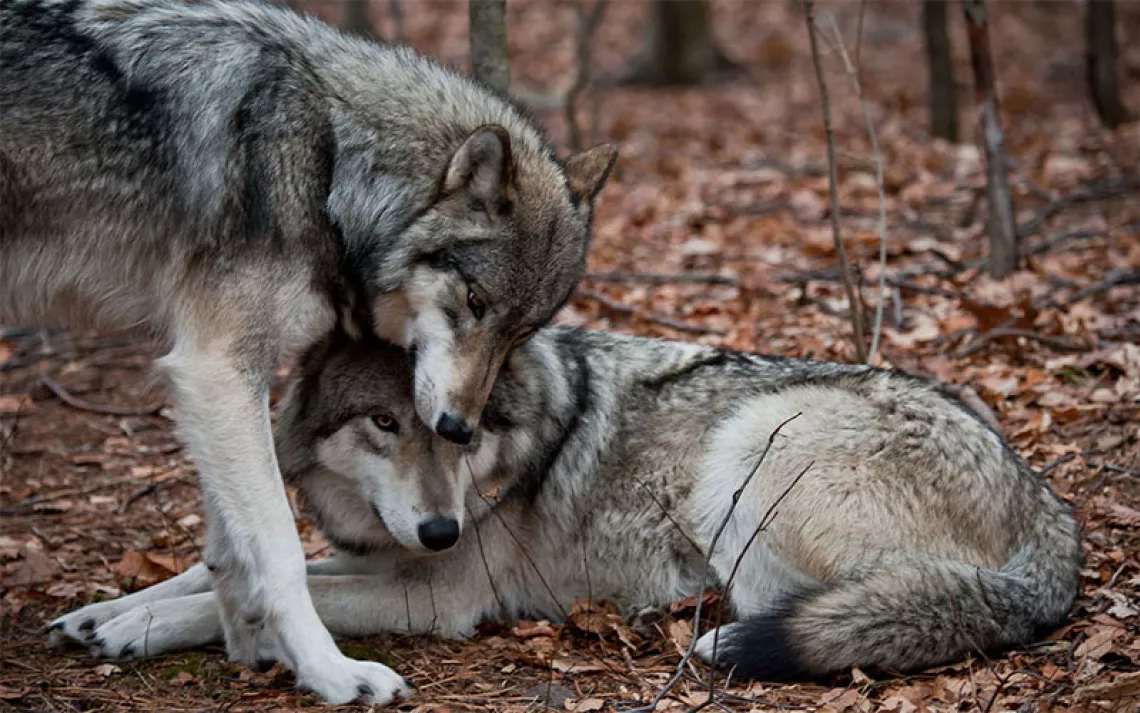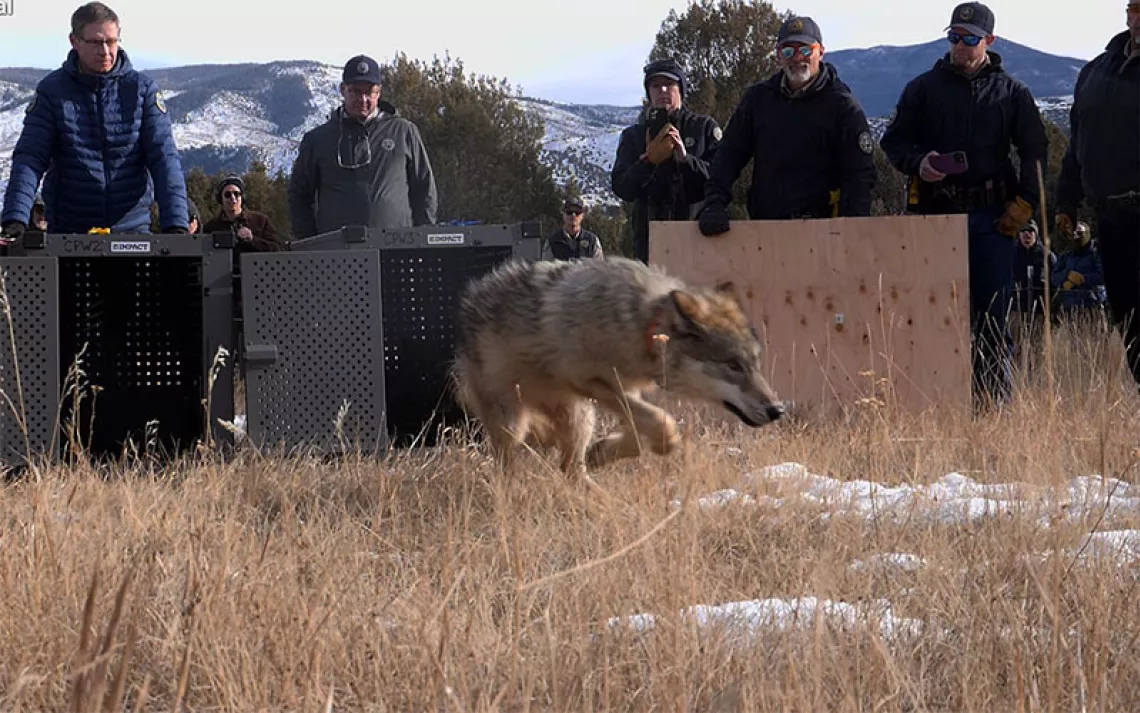Court Throws a Lifeline to Endangered Mexican Gray Wolf
Judge takes Fish and Wildlife Service to task for ignoring best available science

Photo courtesy of the U.S. Fish and Wildlife Service
Exactly 20 years after Mexican gray wolves were reintroduced into the wild, they remain on the brink of survival, with just 114 known wolves roaming southern New Mexico and Arizona. But in early April, a federal judge threw the species a lifeline in a ruling that called for the U.S. Fish and Wildlife Service to revise its management tactics in ways that do more to prioritize the needs of the wolves over the wants of ranchers and hunters.
In an April 2 ruling, U.S. District Court Judge Jennifer Zipps slammed the USFWS for drafting policies that “actively imperiled the long-term viability of the species in the wild.” The ruling came in response to lawsuits from conservation groups Defenders of Wildlife, WildEarth Guardians, and the Center for Biological Diversity. The plaintiffs argued that, in the words of one scientist, the USFWS plan was simply “managing for extinction.” Judge Zipps’s ruling requires the Fish and Wildlife Service to reassess its application of the science and change its approach to these wolves.
Weighing as little as 50 to 90 pounds, its fur tinged with cinnamon, the Mexican gray wolf (Canis lupus baileyi) is the smaller cousin of the more common gray wolf. In the early and mid 20th century, it was shot, poisoned, and trapped nearly to oblivion in a concentrated effort to eliminate carnivores from the American West. At last count, a scant 114 wolves were found roaming their former territories, and their number had increased by only one from the previous year. In the same time it took for the lobos (as they are often called) to reach a population of 100, the gray wolves that were returned to the Greater Yellowstone Ecosystem grew into the thousands. Within just a few years of the Mexican wolves’ return to the Southwest, biologists blamed their slow population growth on intense management practices, including relocating wolves to captivity in response to ranchers’ requests, and restricting their dispersal from a recovery area that was initially just 5,000 square miles.
In 2015, the Fish and Wildlife Service revised its rules for managing Mexican wolves for the first time since the initial reintroductions in 1998. The service raised the population goal from 100 to 325 and increased the animals’ allowed range to 153,871 square miles, concentrated south of Interstate 40, which bisects Arizona and New Mexico. It was the first update to a plan that had been drafted when biologists were still uncertain if a wild population could be rebuilt from a small, “naïve” group of captives.
But conservation groups charged that in the years since wolves were returned to the wild, it was clear that the animals could thrive in the southwestern wildlands—that is, as long as their geographic range, genetic variety, and choices regarding when to remove or kill them was managed with long-term recovery as the chief goal. The 2015 rules, conservation groups charged, failed to provide for the wolves on those issues, and watchdog groups filed a lawsuit against the rule the day it was finalized.
In her ruling, Judge Zipps agreed. “This case is unique in that the same scientists that are cited by the agency publicly communicated their concern that the agency misapplied and misinterpreted findings in such a manner that the recovery of the species is compromised,” the judge’s decision reads. “To ignore this dire warning was an egregious oversight by the agency.”
Among her other criticisms, she called the I-40 boundary “arbitrary and capricious.”
A U.S. Fish and Wildlife Service spokesperson declined to comment, saying the agency is still reviewing the ruling.
For their part, wolf advocates were pleased with the judge’s decision. “The specific point made by the court ruling was that the genetic situation of the wild population is far more dire than the Fish and Wildlife Service is admitting and that none of the actions that they are proposing go far enough to address that,” says Dave Parsons, who worked with the Fish and Wildlife Service to launch the recovery effort in the 1990s and continues to publish research on Mexican wolves.
The decision confirms what conservation groups have long accused the service of doing, he says.
“They are ignoring the best science and developing a plan that will, as the court ruling says, provide short-term survival but not long-term security for Mexican wolves.” The wild population of Mexican wolves descends from just seven animals and therefore faces a genetic bottleneck. The inbreeding reduces the number of pups born each year and the subspecies’ overall health. Alleviating the genetic bottleneck would require a combination of factors: a larger population, a broader geographic range to establish new packs, decreased mortality rates, and new releases from the captive population, which outnumbers the wild population by nearly three-to-one and is more genetically diverse. The Fish and Wildlife Service could achieve its goal, if done right: a 90 percent chance the endangered species will survive for another century.
A research paper outlining that criteria for Mexican wolves was cited in the USFWS’s 2015 rule, but the rule discarded some of that research’s key provisions. The paper’s coauthors cautioned against carrying their math over to a significantly smaller and less genetically diverse population. Doing so, they wrote in their public comment, would be “inadequate to address the current genetic threats” and render the plan “overly optimistic.”
Wolf advocates say they already have a blueprint floating for wolf-management strategies that use the best available science. In 2012, a team of leading wolf scientists drafted a recovery plan that envisions at least 750 wolves spread over three interconnected populations. Their habitat would reach as far north as the greater Grand Canyon ecosystem in Utah and the southern Rockies in Colorado. Large, roadless areas there would allow the animals freedom from encounters with humans—illegal shooting is the leading cause of death for Mexican wolves, according to research Parsons published last year—while also finding abundant deer and elk to prey upon. That proposed habitat is farther north than the historical range of Mexican wolves, but given “an increasingly dynamic and uncertain world,” the additional range would allow the species greater security, according to the draft plan.
“It was that 2012 draft recovery plan . . . that the conservation community puts forth as the best available science, and the judge has more or less affirmed that,” Parsons says.
Jim deVos, assistant director of Arizona Game and Fish, sees it differently. The 2012 draft plan, he says, was based on old and incomplete data. “We took a look at data they choose not to and additional data that became available and came to a different conclusion,” he says.
When the USFWS does reevaluate the science, he’s confident the agency will arrive at the same parameters: a population of about 320 animals in the U.S. and a habitat boundary around Interstate 40. “What we tried to do is come up with the mathematical number . . . that achieved recovery on what I would call a ‘working landscape,’” deVos says. That meant factoring in social tolerance for wolves where they cohabitate with cattle, which then join their food sources. Arizona Game and Fish staff members have coauthored research that argues for balancing genetic goals with social challenges. “It’s a balancing act,” he says. “It’s very, very difficult to try and convince people that are in this working landscape that wolves belong there.”
The judge’s ruling acknowledges that difficulty but reaffirms that the Endangered Species Act’s purpose can’t be compromised to appease those concerns. It does not, however, mandate immediate adjustments in management, so the program will continue as is while the USFWS works on its response to her order.
What’s more important than this latest court decision, observers on all sides agree, is the pending litigation against the latest recovery plan. That plan was finalized in November and has also been challenged in court. It copies over some of the same management provisions seen in this 2015 rule, capping the population in the U.S. at just over 300 wolves south of Interstate 40.
“One can either interpret that as ‘Oh, wow, what a coincidence. They took a guess in the rule-making process and then they did rigorous science and they found out their guess was spot on,’” says Michael Robinson, with the Center for Biological Diversity. Having read the notes from the meetings held to draft the recovery plan, Robinson offers a different interpretation: “They wanted to get [the population cap] to 320 and they put a series of numbers into a fairly complex model . . . and they tweaked those very carefully with the goal of reaching the exact same numbers that they’d come up with in the rule-making process.”
That’s not how science works, he charges.
“Real science is not goal-oriented,” he says. “Real science tries to understand phenomena rather than find some pre-conceived answer.”
The recovery plan lawsuit will also be heard by Judge Zipps and is expected to be scheduled in the next couple of months.
These cases could mark a turning point for Mexican wolf recovery, Robinson says, but “a lot will depend on the timeline. If the judge gives them another 20 years to work this out, a lot of damage will be done in that span of time.”
 The Magazine of The Sierra Club
The Magazine of The Sierra Club



